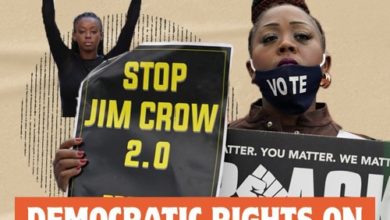Iowa represents about 1 percent of the national population, and this year’s 16 percent turnout of eligible Iowa voters was considered high. Yet in the country’s distorted “democratic” system, states that vote early like Iowa have a far outsized influence in national politics.
Given how they are organized, the Iowa caucuses are always an oddity. This year was no different — with several Democratic precincts settling their votes with a coin toss, and many working-class voters locked out by the sheer amount of time necessary to participate. Despite the somewhat farcical aspects of the Iowa process, there are nonetheless several important takeaways.
One is that the fragmentation and division in the Republican and Democratic contests, with no clear front-runner, is likely to drag on through the majority of the nominating season.
Secondly, the various candidates continue to attract distinctive sectors of the electorate and tendencies within the ruling class. In this sense, the internal unity of both parties is being severely tested.
The ruling class generally displays a high level of class consciousness and unity, especially when in combat with poor and working people. That class of exploiters permits a certain degree of internal conflict to be expressed publicly, and utilizes the election season especially to allow social discontent to be vented safely and organized around different bourgeois trends.
This election season, however, is somewhat different, allowing highly unconventional candidates to flourish, even threatening an “extreme” electoral outcome, to quote the alarmed Wall Street Journal editorial board.
Sanders, the Democratic base and socialism
The Democratic caucus ended in essentially a tie between Hillary Clinton and Bernie Sanders.
That Sanders, a self-proclaimed socialist who has lived for decades on the fringes of the Democratic Party, could tie the Clinton machine is a huge turnaround. Sanders was down by 41 points in the first Iowa poll last year and his campaign was generally considered non-competitive.
Sanders’ program is mostly a reworked version of the New Deal-Great Society liberalism that was vanquished from the Democratic Party during the 1980s and 1990s. That liberal program has represented the “soul” of Democratic Party for much of the 20th century, which is why Democratic candidates still appeal to it rhetorically while doing little to advocate for its policies.
The Clintons were the principal forces that defeated liberalism within the Democratic Party. But Sanders is proving that liberal and social-democratic policies still resonate strongly with the Democratic base. The vast majority of the Democratic electorate wants to see a country where the living standards of working people improve and that is broadly inclusive, to some degree or another, of oppressed communities.
Despite her decades of work moving the Democratic Party sharply to the right, Clinton is now using the rhetoric of the left — even implying that she won’t “just” go after Wall St. (referring to Sanders) but also the pharmaceuticals and other corporations.
Sanders advocates a capitalist reform program and probably would not call himself a socialist at all if it weren’t for the fact that it has been his political label for so long. Nonetheless, his agitation against the rigged economy and his socialist label have brought to the surface important conversations about the capitalist system itself. When the Tea Party falsely called Obama a socialist, this in fact generated curiosity about socialism and helped lift the stigma around it; Sanders’ initial successes, now as a self-proclaimed socialist, are continuing this trend.
This again, speaks to why the Sanders phenomenon is, broadly speaking, a positive indicator for those who desire to replace capitalism with socialism.
For one, Sanders is, somewhat inadvertently, mainstreaming the idea of an alternative to capitalism in the most pro-capitalist country in the world. Second, he clearly is revealing there is a mass base for radical ideas. Third, his rhetoric of “political revolution” is leading to a mass of people, mostly young, arguing that the whole political establishment must be challenged and replaced to implement sweeping changes, and that the president alone cannot save them.
None of this diminishes or cancels out Sanders’ pro-imperialist foreign policy, his incorrect definition of socialism, or the illusions he spreads about how change can be won. Nor has Sanders moved one bit from his pledge to funnel his campaign supporters behind Clinton — to strengthen the Democratic Party rather than an independent people’s movement — if he loses the nomination. But it would be foolish for socialists to close their eyes to the positive political lessons of Sanders’ performance in the primaries.
Clinton’s tactic, by contrast, is to pander to a sort of cynicism, to suggest broad change is impossible and unrealistic. She presents herself as the pragmatist fighting for smaller policy changes that will help working people in the short term to lay the basis for more expansive change in some far-off future.
This is slick demagogy: the Walmart director, Wall Street defender, welfare cutter and war-hawk now trying to rebrand herself to appeal to the same Democratic base as Sanders.
The most clear divide between the candidates’ supporters is not income but age. With the youth vote Sanders absolutely routed Clinton, gaining 84 percent of voters 18-29 (although they made up the smallest share of the electorate).
The generational gap has less to do with ideology and political vision — middle-aged Democratic voters have largely the same ideals as their younger counterparts — and more to do with the fact that older Democratic voters have had their expectations lowered by decades of right-wing assault and Democratic Party hand-wringing. Younger voters want a Democratic Party that will fight Wall Street and fight the right, not one that perpetually seeks accommodation.
Republicans: ultra-right in command
On the Republican side, the clearest takeaway from Iowa is that the ultra-right politics of the Tea Party are in full command. The so-called “moderate” third place finisher, Marco Rubio, was one of the key figures of the 2010 “Tea Party Wave” election. His entire campaign this year has been predicated on reversing the steps he took towards the “center” in his early Senate career.
The other top four vote-getters (Cruz, Trump, Carson, Paul) also share in common that they rose to prominence in the wake of the Tea Party and constitute different hues of the far-right of the GOP.
The Republican Party espouses a free-market fundamentalism aimed at maximizing profits for capitalist elites. In order to have a mass appeal it wraps its economic program — amounting to a full-scale assault on the working class — in the American flag and a set of contradictory “conservative values.” The Republicans harken back to a mythical “golden age” and lament that the U.S. has been “in decline.”
While the GOP candidates are individually more diverse than ever, their common narrative is to present the demographic and cultural changes that have taken place in the second half of the 20th century (inclusion of Blacks, women, LGBTQ people and immigrants) as the cause of the massive economic instability for previously stable and relatively privileged sections of the population. Immigration, affirmative action, women’s and LGBTQ rights, etc. are all presented this way — a sort of conspiracy between Washington elites and minorities against “traditional” America.
The top Republican candidates are the ones that are 1) doing the best at channeling this right-wing brew of bigotry and populist anger 2) have the smallest connection to the pre-Tea Party Republican Party.
Trump’s “make America great again” just boils down this whole Republican program into a pithy slogan. All throughout Europe, far-right racists and nationalists, from Marine Le Pen in France to Viktor Orban in Hungary, are using the same strategy to build semi-fascist movements still within the framework of bourgeois democracy.
Only mass social struggle can defeat the far right
Out of either fear or sheer loathing of the far right, many progressive people are looking to a Democratic Party victory to stop the far right.
To stop right-wing populism, it is important to understand how it has grown. Economic dislocation in the United States has been caused by three decades of non-stop austerity. It has been a bipartisan effort. Its aim has been to maximize profit and drive the various sectors, strata, and identities of the working class into a race to the bottom of the increasingly globalized economy.
Because this imperialist system has been constructed in real time, with various levels and types of oppression that exist in addition to class exploitation, racism is embedded into the country’s economic stratification as well as its social reality. This makes the task of uniting the working class all the more difficult, and allows the far right, in the absence of a strong and independent left, to maintain its hegemony over large sections of the white working and middle classes.
If Sanders were to win the nomination, much of the ruling class — including its so-called “moderate” elements — would unite behind a third-party candidate, like Michael Bloomberg, or the Republican candidate, even the far-right Trump or Cruz, who they currently find embarrassing and loathsome. That is how determined they are to prevent FDR-style liberalism, not to mention mildly socialist rhetoric, from becoming a powerful political current in this country again. To them, that is far more dangerous than far-right extremism.
If Clinton were to win, her connections to the political establishment and the banks are so strong that she is more likely to turn out disgruntled white people to the Republican Party than she is to inspire progressive whites and oppressed communities to turn out on her behalf. Again, Sanders is pledging to fold his progressive supporters back into her campaign, which would demobilize and demoralize the movement behind him, and hand the populist angle back to the far-right.
In short, the bourgeois electoral system cannot restrain or defeat the far right, but is likely to only facilitate its rise. The fragmented and chaotic state of both capitalist parties could lead to new political realignments and a protracted period of instability. This means preparing for sharper struggles within the capitalist class, against the far right and in defense of poor and working people.
Instead of yielding to fear and alarmism in the face of increasing polarization and instability, revolutionaries must search for new opportunities to increase the contradictions among the ruling class, to build united fronts to advance the class struggle and fight the far-right, and to expose the undemocratic capitalist system for what it really is.
This is the message of struggle that PSL members, including the presidential campaign of Gloria La Riva and Eugene Puryear, are taking into the streets, schools, workplaces and neighborhoods across the country.






